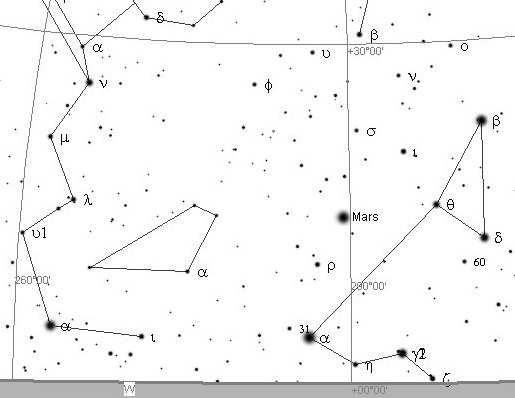|
4. When in November Leo reappears in the early night after having been impossible to see - after having performed the function of 'house' for Sun - the Leonids sometimes are swarming out from the Leo house. This piece of knowledge could have been diluted to common people in form of a statement that every 33 years a great shower of sparks would follow from Sun (the Great Fire in the sky) visiting Leo. There was a 33-year long cycle connected with a conjuntion of Sun with Leo.
In the other time direction (forward) was the horizon in the west where Leo was bound to disappear shortly after Sun, with the shower of flying stars like a sign of his head being smashed to smithereens. The direction down is confirmed both by the ecliptic path of Sun and by the undulating Hydra body. I decide to try a star program (Cartes du Ciel) in order to ascertain what an observer on Easter Island could have seen in the year 1870 (when the officers of the Chilean corvette O'Higgins were given the G tablet). As a first input to the program is demanded latitude and longitude for the observatory, and for Hanga Roa the values are 27° 9′ 0″ S and 109° 25′ 30″ W. The date 1870-11-14 does not allow any view of Regulus later than about 8 p.m. - beyond which the star has descended. This is how the output looks for 20.00 (from the sea level):  Mars happened to be close to Leo at that time. The triangle defined by β, δ, and θ is the same as the one I mentioned on the previous page, but south of the equator it becomes oriented 'upside down'. The head and the mane of the Lion are on the verge of 'being swallowed' by the horizon in the west. I imagine the Leonids may have been thought of to be caused by the heads of Lion and Sun together colliding with Mother Earth. At left are Sextans and the beginning of Hydra. Alphard is going down at about the same time as Regulus. But, we know, Alphard is crossing the meridian straight above us at midnight 153.7 - 143.3 = 10 days earlier than Regulus.
The horizon is not a good 'instrument' for measuring time, it should instead be measured at the meridian. Time should not be measured by observing stars rising and descending but when they are passing overhead. The curvature of the Earth makes stars at higher declinations rise earlier and descend later than those at lower declinations. Stars close to the pole never descend.
Yet, at special occasions the horizon was probably observed. We should remember Anax, the Bringer of Spoils (cfr at Boanerges):
... The 'giver of bread' (Lord) should indicate the king who enters at the beginning of summer (through the Π door) and the 'bringer of spoils' (Anax) the other king who enters at the beginning of winter (through the underground Η door). The ceramic fragment depicts the Lord King upside down - he has turned around from a 'cap' position to a 'cup', he has 'toppled'.
The change from ruler's cap to beggar's cup, so to say, the change from the season of plenty to the season of hunger, could have been looked for by observing where Sun was descending against the horizon. Equinox is independent of the latitude of the observer.
Looking towards the horizon in the west in the early evening there could be a time when those living in the tropical belt suddenly felt the need to lean their heads in the opposite direction in order to continue to see the cap, or in the case of women - to continue to see the cup:
But such a change should be at noon. As a possible evidence I wish to remind the reader of Atea who changed her sex (cfr at Heuheu respectively at Argo Navis): ... Ta'aroa sat in his heaven above the earth and conjured forth gods with his words. When he shook off his red and yellow feathers they drifted down and became trees. He created the first parents, Tumu-nui, Great Foundation, to be the husband, and Paparaharaha, Stratum Rock, to be the wife. He put the very essence of himself into their creation; yet when he commanded them to wed, each refused to go to the other. So Ta'aroa created other gods and Atea, Bright Expanse, the Sky-goddess, who dwelt in darkness in the confined sky Rumia. By Papa-tuoi, Thin Earth, Atea was the mother of children who became artisans for Rai-tupua-nui, Great-Sky-builder. They assisted him in erecting the ten heavens above the earth. In the highest of these dwelt the god Tane, so it was called the Sky-of-the-sacred-omens of Tane and Sky-of-the-water-of-life of Tane. The next highest heaven was called Hiro's Sky-of-prophets. Atea then became the wife of Rua-tupua-nui, Source of Great Growth, and they became the parents of all the celestial beings, first the shooting stars, then the Moon and the Sun, next the comets, then the multitude of stars and constellations, and finally the bright and dark nebulae. When this tremendous task had been accomplished Atea took a third husband, Fa'a-hotu, Make Fruitful. Then occurred a curious event. Whether Atea had wearied of bringing forth offspring we are not told, but certain it is that Atea and her husband Fa'a-hotu exchanged sexes. Then the [male] eyes of Atea glanced down at those of his wife Hotu and they begat Ru. It was this Ru who explored the whole earth and divided it into north, south, east, and west.
|



